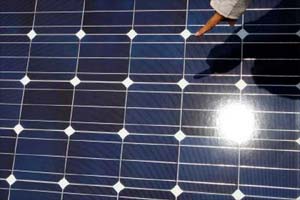With abundant sunshine across the country for nearly 300 days a year, India was always considered ideal for production of solar energy. But the sun truly shone on the sector only last year, which saw tariff plunging to record lows and foreign companies making aggressive forays to tap the growth potential, with domestic companies too showing significant interest.
An inflection point was reached when solar tariff plunged to below
Rs 5 per unit for the NTPC-conducted bid under the National Solar Mission (NSM) late last year. United States-based SunEdison bagged the bid at
Rs 4.63 per unit for 500 MW to be installed in Andhra Pradesh. This meant that solar had achieved grid parity—the cost of solar power being on a par with thermal power—an outcome that was estimated to materialise much later, in 2018. In bids in January this year, a Finnish company went further, quoting Rs 4.34 per unit in Rajasthan.
It is hardly a coincidence then that the country installed roughly the same amount of solar power in FY2016 that it had done in the previous three years taken together.
Several factors were behind this change. Regulatory support from the government that hiked the quantum of mandatory sourcing of renewable power for distribution companies was one. A glut of solar photovoltaic cells in the Chinese market driving down costs, lower commodity prices, saturated markets in Europe and the US and lower capital costs also boosted the country’s plan to ramp-up renewable capacity in a very short time.
Although the seeming success of the solar story has led to investors queuing up, questions have been raised about its sustainability, especially on the question of low tariffs. A part of industry and some experts believe solar could go down the same road as some thermal projects which were tendered out at very low tariffs. Some of these projects have been facing losses due to factors that the firms failed to take account of in their low bids.
“The low tariffs are good for the industry as it creates demand. Time will tell if the winning firms are able to generate an acceptable rate of return on those tariffs,” Sujoy Ghosh, country head, FirstSolar tells FE, adding that currency fluctuations and higher interest rates globally could hamper the expected returns from these projects.
Ghosh, however, points out that unlike thermal projects, solar projects have fewer elements of risk especially on fuel. He singles out capital cost, which constitutes the bulk of the solar costs, as possibly the most important factor in companies being able to derive adequate returns on low tariffs.
The trend of fall in tariffs has not been uniform though, with a massive gap existing between tariff discovered in bids invited by NTPC and that for bids invited by state-owned utilities. While the tariff trajectory was downward through the July-November period last year, it remained close to Rs 6/unit for bids invited by states. With NTPC receiving bids that are nearly 20% lower, some state governments have started delaying signing of power purchase agreements.
Telangana that had got average winning bids of Rs 5.70 per unit, started negotiating for lower tariffs in light of the NTPC bids. This has injected an element of uncertainty in state projects. Considering that the bulk of the capacity installation in 2016 is to take place in states, such uncertainty could hamper forward movement.
“NTPC has received lower bids because it’s a stronger counter-party than any of the state-owned utilities and has less payment risk attached to it. It would be wrong on the states’ part to ask us to lower tariffs after the bidding process,” a solar power developer said on condition of anonymity.
While grid-connected large solar plants have attracted investors, growth in rooftop installations has not picked up. The current rooftop installed capacity in the country is about 400 MW while the government aims to install a whopping 4.8 GW by the end of this year.
Industrial and commercial buildings have been at the forefront of such installation, with residential buildings lagging behind due to the lack of clarity on government support and infrastructural issues. Though government structures have started issuing tenders for rooftop solar installations, considering the fact that rooftop capacity is to contribute 40% (40 GW) of the overall capacity addition target for 2022, the progress so far has been underwhelming.
A recent Cabinet decision sanctioning Rs 5,000 crore for 30% capital subsidy on rooftop installations is likely to boost the sub-sector. “We believe this subsidy scheme will result in growth of the rooftop sector in the short-term. In the long-term, this market needs a concerted effort from the government on policy and regulatory front to achieve its growth potential in a sustainable manner,” Bridge to India, a solar consultancy firm, said in a statement.
